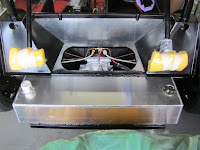I didn't want to try and fit the sump on a quick evening session, I don't want to be stuck part way through that job with the engine on a hoist & have to leave it overnight.
So on to a smaller job - I thought I would mark up the bell housing cut out & some little jobs on the gearbox assembly.
Pivot change
The GBS solution to getting the correct throw at the clutch release bearing is a change to the pivot point - the old one (smaller) is removed by tapping out from behind, then the new larger one tapped in - using my 'wooden dowel' drift and a hammer:
Clutch release bearing & arm
Unpacking the release bearing I ran into a problem - it looks like it has suffered in transit/packing. The broken edge doesn't look terminal, however this part is approx a £20 value & is engine out time if it completely fails. I'm going to have a chat with GBS, but think I am going to invest in a new one.
Rats!
Offered everything up to check the fit & new pivot position, then removed until I get the replacement release bearing:
Bell housing adjustment
I marked up the required change on the bell housing, I'm going to double check some other blogs before cutting - the second picture shows two alternative cut lines, the higher one starting at the point the bell housing changes from straight to conical:
References:
Phil Howard's build
RHOCaR topic
RHOCaR topic #2
RHOCar topic #3 + picture of starter mount change
From these references it looks like my line needs to be parallel to the bottom of the housing, rather than across the corner as I have it marked.
Then I thought: If the gearbox, for any reason, fell off the bench its going to fall on the car and break something permanently - so its now sitting on the floor.
The sump is sitting under the pink sheet to the right - clean and dust free. I really want to install that first before doing any cutting since aluminium dust/shavings will go everywhere when I cut into the housing.
The sump is sitting under the pink sheet to the right - clean and dust free. I really want to install that first before doing any cutting since aluminium dust/shavings will go everywhere when I cut into the housing.



















































